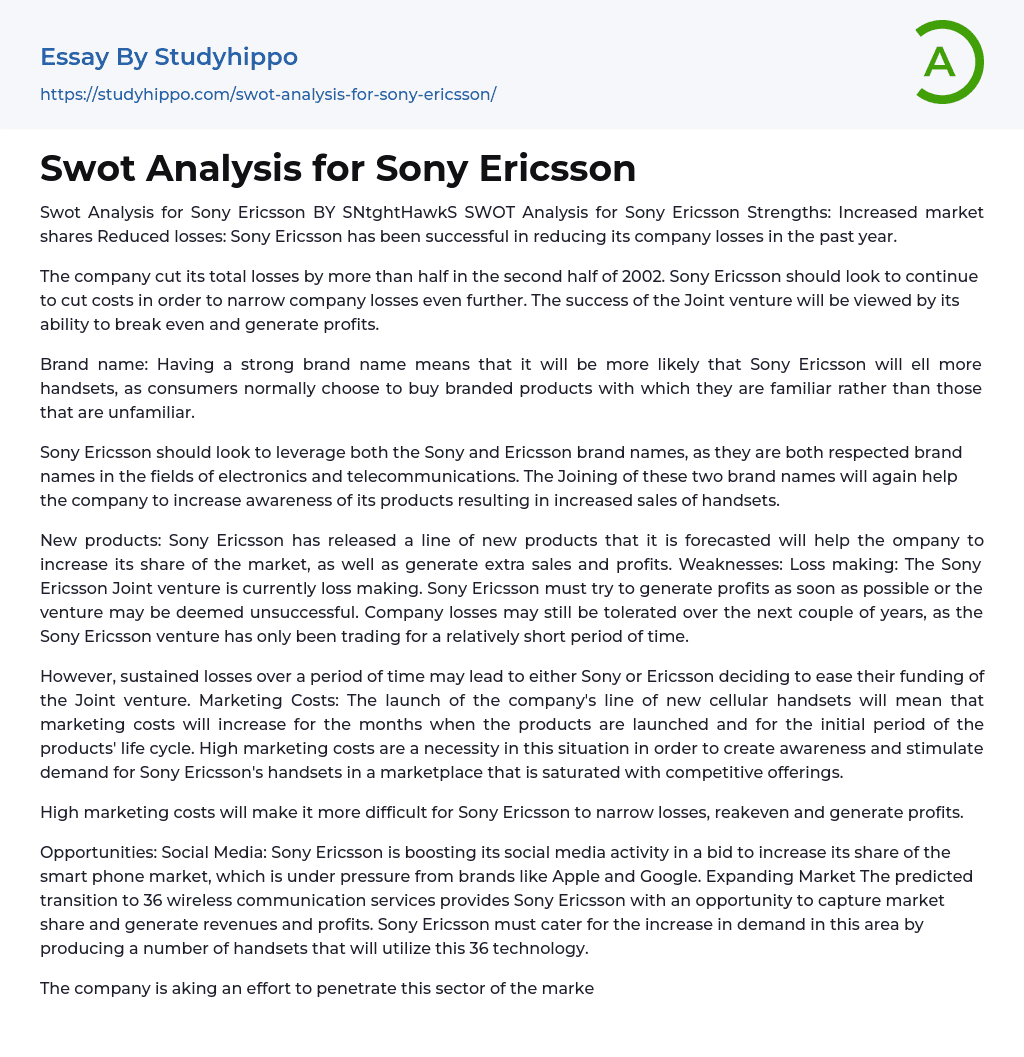Strengths: Increased market shares
Reduced losses: Sony Ericsson has been successful in reducing its company losses in the past year.
The company cut its total losses by more than half in the second half of 2002. Sony Ericsson should look to continue to cut costs in order to narrow company losses even further. The success of the Joint venture will be viewed by its ability to break even and generate profits.
Brand name: Having a strong brand name means that it will be more likely that Sony Ericsson will ell more handsets, as consumers normally choose to buy branded products with which they are familiar rather than those that are unfamiliar.
Sony Ericsson should look to leverage both the Sony and Ericsson brand names, as they are both respected brand names in the fields of electronics an
...d telecommunications. The Joining of these two brand names will again help the company to increase awareness of its products resulting in increased sales of handsets.
New products: Sony Ericsson has released a line of new products that it is forecasted will help the ompany to increase its share of the market, as well as generate extra sales and profits. Weaknesses: Loss making: The Sony Ericsson Joint venture is currently loss making. Sony Ericsson must try to generate profits as soon as possible or the venture may be deemed unsuccessful. Company losses may still be tolerated over the next couple of years, as the Sony Ericsson venture has only been trading for a relatively short period of time.
However, sustained losses over a period of time may lead to either Sony or Ericsson deciding to ease their funding of the
Joint venture. Marketing Costs: The launch of the company's line of new cellular handsets will mean that marketing costs will increase for the months when the products are launched and for the initial period of the products' life cycle. High marketing costs are a necessity in this situation in order to create awareness and stimulate demand for Sony Ericsson's handsets in a marketplace that is saturated with competitive offerings. High marketing costs will make it more difficult for Sony Ericsson to narrow losses, reakeven and generate profits.
Opportunities: Social Media: Sony Ericsson is boosting its social media activity in a bid to increase its share of the smart phone market, which is under pressure from brands like Apple and Google. Expanding Market The predicted transition to 36 wireless communication services provides Sony Ericsson with an opportunity to capture market share and generate revenues and profits. Sony Ericsson must cater for the increase in demand in this area by producing a number of handsets that will utilize this 36 technology.
The company is aking an effort to penetrate this sector of the market and has had some success in doing so. However, Sony Ericsson still trails industry rivals such as Motorola, NEC and Panasonic within the 36 sector of the market. Phone Design and Accessories: Sony Ericsson must monitor the latest trends in customer preferences for the design of handsets and the accessories provided for use in conjunction with handsets.
For example, camera phones are expected to increase in popularity over the coming years. The increase in popularity of camera phones presents Sony Ericsson with an pportunity to increase its revenues and generate profits, as camera phones have
a much higher average selling price than normal voice phones. Popular Handset Technology Threats: Strong Competition: Sony Ericsson faces strong competition in the marketplace from a number of industry rivals. The company's competitors include Nokia, Samsung, Panasonic, LG Electronics, Motorola, Siemens and NEC. Sony Ericsson will also encounter increasing competition from up and coming Chinese cellular handset manufacturers such as TCL, Bird, Eastcomm and Legend.
All of these companies will combine to take away sales and market share from Sony Ericsson. Pricing Pressure: The increasing competition in the cellular handset market will inevitably lead to pricing pressure. Pricing pressure will lead to a squeezing of Sony Ericsson's margins. This will mean that the company will have to seek to cut its costs if it is forced to reduce the price of its products. Failure to do so could mean that the company will continue to make losses or only generate modest profits, when the potential is there for the company to achieve much more.
- Chief Executive Officer essays
- Convenience Store essays
- Firm essays
- Training And Development essays
- Unilever essays
- Variable Cost essays
- Virgin Group essays
- Bargaining essays
- Entity essays
- Pest analysis essays
- Advertising essays
- Audience Theory essays
- Competitor Analysis essays
- Consumer essays
- Marketing Management essays
- Marketing Mix essays
- Marketing Plan essays
- Marketing Research essays
- Marketing Strategy essays
- Point Of Sale essays
- Price essays
- Procurement essays
- Product essays
- Product Differentiation essays
- Promotion essays
- Promotion And Marketing Communications essays
- Retailing essays
- Trademark essays
- Anheuser-busch essays
- Brands essays
- Detergent essays
- Product Placement essays
- Research Design essays
- New Product Development essays
- Advertisement essays
- Brand essays
- Sales Promotion essays
- Advertising campaign essays
- Consumer behaviour essays
- Offer And Acceptance essays
- Wal-Mart essays
- Discover essays
- John Locke essays
- 9/11 essays
- A Good Teacher essays
- A Healthy Diet essays
- A Modest Proposal essays
- A&P essays
- Academic Achievement essays
- Achievement essays




